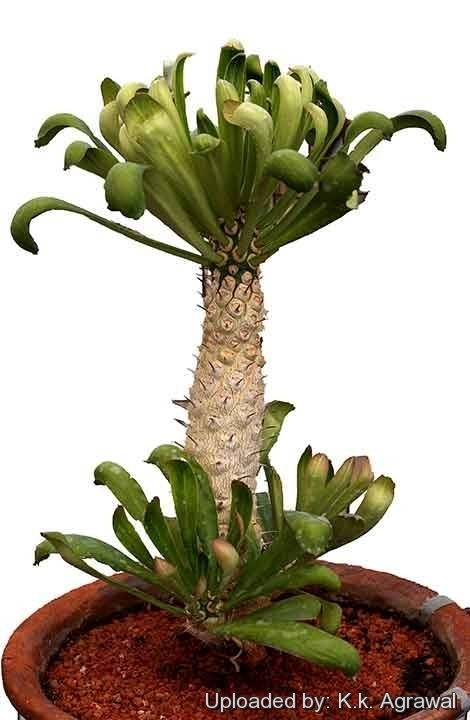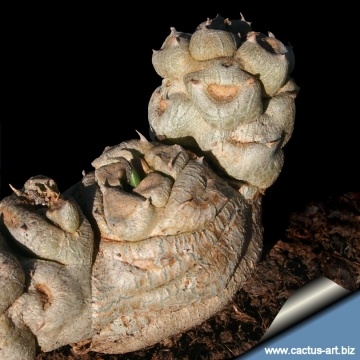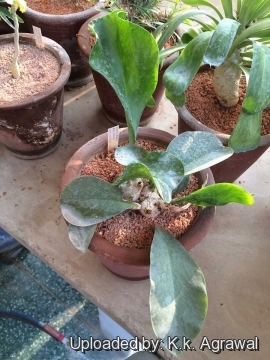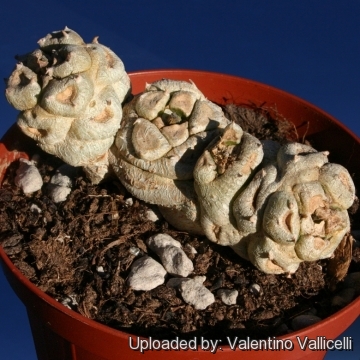
Euphorbia poissonii Photo by: K.k. Agrawal
Origin and Habitat: Tropical West Africa from Guinea to North of Nigeria. Irregular distribution, locally common and gregarious.
Altitude range: 400-700 metres above sea level.
Habitat: it grows on rocks and stony soils in open Monotes woodland with grass, and on rocky hills in dry savanna. The plant is sometimes cultivated, and often found in fields and villages in Dahomey.
Synonyms:
See all synonyms of Euphorbia poissonii
back
Accepted name in llifle Database:Euphorbia poissonii PaxBull. Mus. Hist. Nat. (Paris) 8: 62 1902Synonymy: 2
back
Common Names include:
ENGLISH: Candle Plant, Cylindrical Euphorbia
Description: Euphorbia poissonii is an erect much-branched succulent shrub 1.2-2(-3) m high, with candelabriform branching with one to several columns and topped with large green leaves during the growing season, occasionally sub-spiny.
Stems: Branches cylindrical, stout, succulent, often indistinctly tessellate, (2-)3-3.5(-4) cm thick green to silvery-grey on old trees, smooth, glabrous, full of white latex.
Spines: Not spiny or sometimes with rudimentary, single spines, somewhat blackish, 3-8(-15) mm long, spirally-arranged, or with spines present only on young plants. So it would appear E. poissonii can be spineless or have one spine.
Leaves Alternate, sessile, deciduous, pale green and somewhat glaucous at base, spirally-arranged or in 8-10 ranks at the apex of the branches, 5-14 cm long and 2-7 cm across, glabrous, fleshy, spatulate or triangular, with a notched or truncate apex, sometimes torn into thin strips, and a tapered. Nerves Pinnate, only the midrib is clearly visible. For the most part of year leafless, only leafing for two or three months, during the rainy season.
Inflorescence: One or two flowers at the end of a shared short peduncle set on the upper edge of a leaf scar.
Flowers: Short peduncled yellow/green or greenish with red stamens, 10-12 mm in diameter, bud trigonous, ornamented with 5 red glands.
Blooming season: It flowers at the end of the dry season, before coming into leaf.
Fruit (capsules): Trilobed, more or less globose, grey to beige when ripe, glabrous, about 6 mm in diameter, at the end of a 6-12 mm long, bent pedicel.
Related species: Euphorbia poissonii is strictly related and often synonymized with Euphorbia venenificaSN|21556]]SN|28017]] Trem. and Euphorbia unispina N.E.Br. Its leaves look like those of Euphorbia desmondii Keay & Milne-Redh., whose branches are angular, 3-5 sided and non-cylindrical. It is also related to Euphorbia sudanica Chev., Euphorbia nivuliaSN|28042]]SN|28042]] Buch.-Ham. (India), Euphorbia neriifolia L. (India), Euphorbia qarad Defl. (Arabia), Euphorbia amicorum, Euphorbia deciduaSN|28017]]SN|21556]], Euphorbia imitata, and Euphorbia brevis.
Bibliography: Major references and further lectures
1) A. R. Smith, Susan Carter “Flora of Tropical East Africa - Euphorbiacee” volume 2 (1988) CRC Press, 01/giu/1988
2) Michel Arbonnier "Trees, Shrubs and Lianas of West African Dry Zones" Editions Quae, 2004
3) Hans Dieter Neuwinger “African Ethnobotany: Poisons and Drugs : Chemistry, Pharmacology, Toxicology” CRC Press, 1996
4) Georg August Schweinfurth “The heart of Africa: three years' travels and adventures in the unexplored regions of Central Africa from 1868 to 1871” Volume 1 Gregg, 1969
5) “Medicinal Plants” Volume 1 PROTA, 2008
6) Werner Rauh “The Wonderful World of Succulents: Cultivation and Description of Selected Succulent Plants Other Than Cacti” Smithsonian Institution Press, 1984
7) William Julius Eggeling “The Indigenous Trees of the Uganda Protectorate” Government Printer, South Africa, 1940
8) Hermann Jacobsen “Abromeitiella to Euphorbia” Blandford Press, 1960
9) Urs Eggli “Illustrated Handbook of Succulent Plants: Dicotyledons” Springer, 2002
 Euphorbia poissonii Photo by: Cactus Art
Euphorbia poissonii Photo by: Cactus Art Euphorbia poissonii Photo by: K.k. Agrawal
Euphorbia poissonii Photo by: K.k. Agrawal Euphorbia poissonii Photo by: Valentino Vallicelli
Euphorbia poissonii Photo by: Valentino VallicelliSend a photo of this plant.The gallery now contains thousands of pictures, however it is possible to do even more. We are, of course, seeking photos of species not yet shown in the gallery but not only that, we are also looking for better pictures than those already present.
Read More... Cultivation and Propagation: Very slow growing and cold sensitive species can to grow in both pots and in the ground in areas with mild climate, but they can even be grown indoors. Sun Exposure: Light shade. They grow well in a very draining mineral potting substrate. During the summer, they enjoy average feeding and watering. When dormant, plants are relatively cold tolerant.
Propagation: Usually by seeds, it can also It be propagated by cuttings; if you remove an offset, remember to let it dry for a week or so, letting the wound heal (cutting planted to soon easily rot before they can grow roots). It is better to wash the cut to remove the latex.
Warning: When a plant get damaged it exudes a thick white milky sap known as latex. This latex (resin) is poisonous contains some of the most potent irritants known. The latex is particularly dangerous for the eyes, skin and mucous membranes. So pay extreme attention not to get any in your eyes or mouth. Cultivated plants must be handled carefully.
Uses:
Edges: Often planted as hedgerows around fields and cemeteries (animal pens, fencing to prevent cattle roaming, boundary marking)
Traditional medicine: Latex Powerful and irritant caustic substance, purgative. Hair removal, tooth decay and extraction. Roots Lethal to molluscs (notably Bulinus, vector of schistosomiasis).
Flowers: Liked by bees and many other insects. Apiculture.
Poison: Latex Poison for hunting', fishing and criminal purposes (cow milk is said to be the antidote), birdlime.
- A piece of the stem is commonly in Mali mixed with other ingredients in preparing arrow-poison. The latex is a powerful caustic, and its action seems to be solely as such for it is irritant to mucous membrances and in direct contact with tissue, but has no action on the heart, respiration or nervous system.
- The Jukun of N Nigeria have used the plant-sap as a potent poison when added to food, drinking-water, kola nuts, etc.
- In Sokoto some tribes use the plant as a fish-poison.













